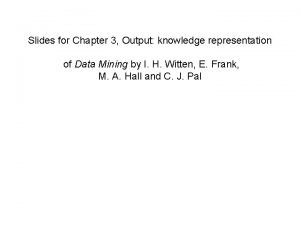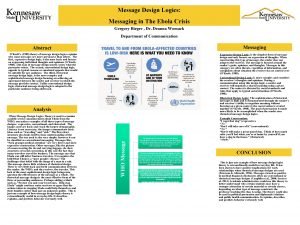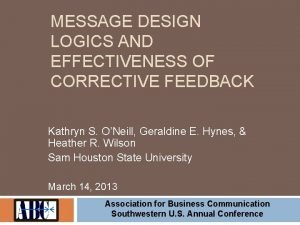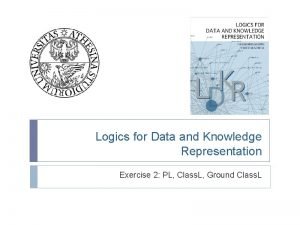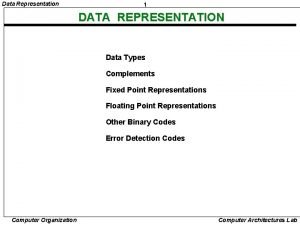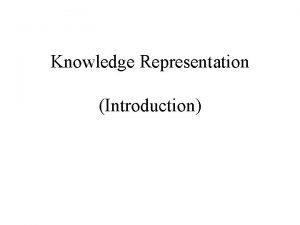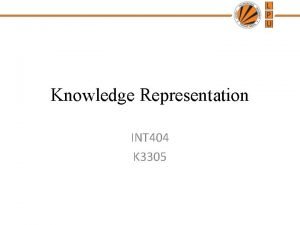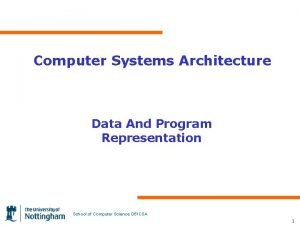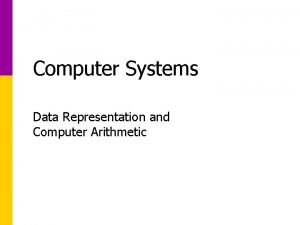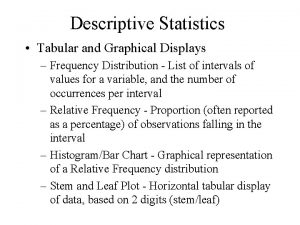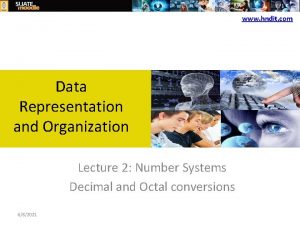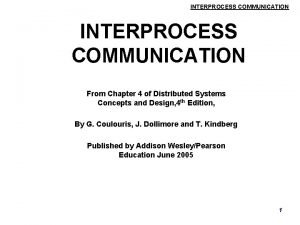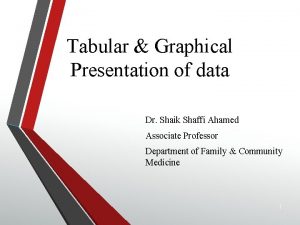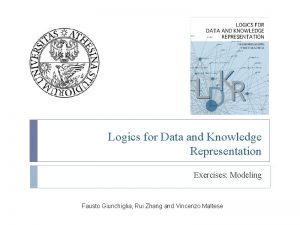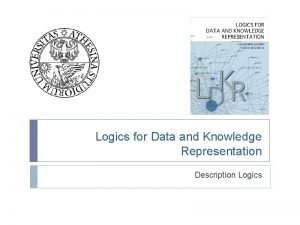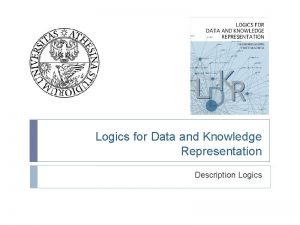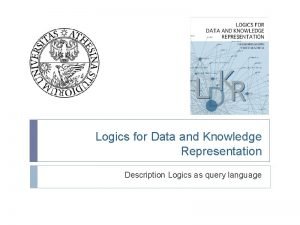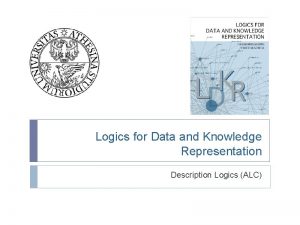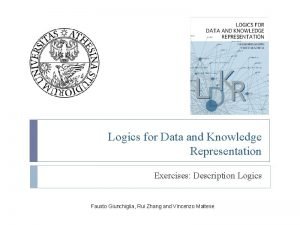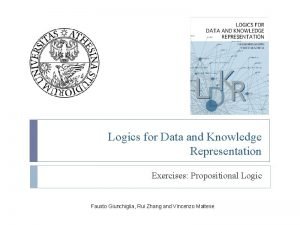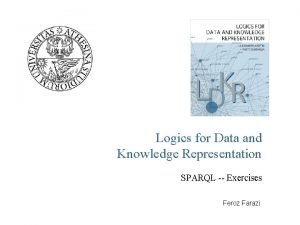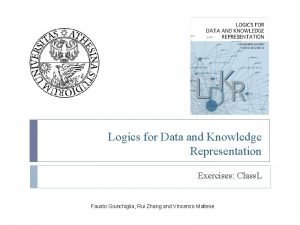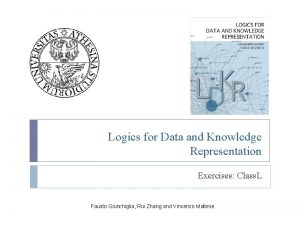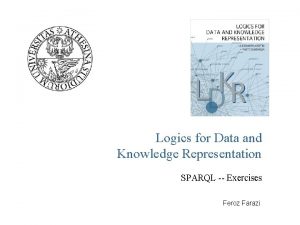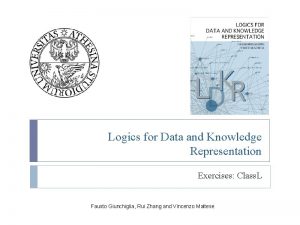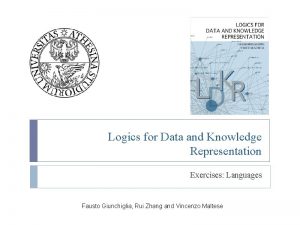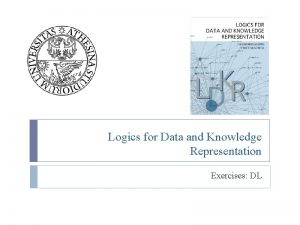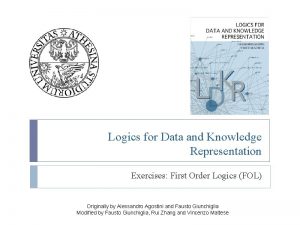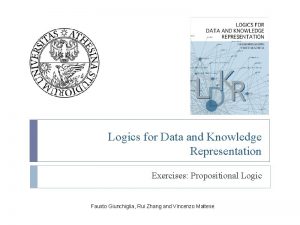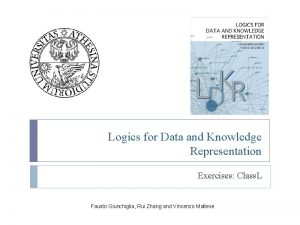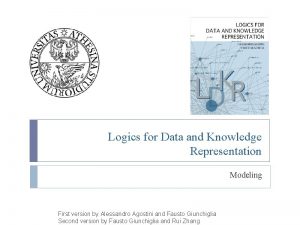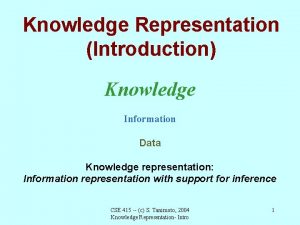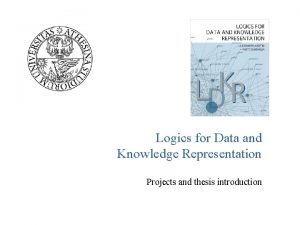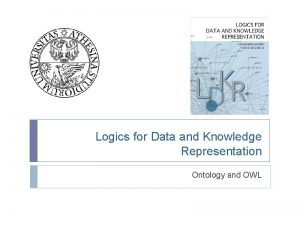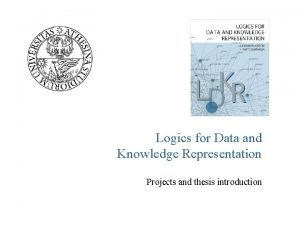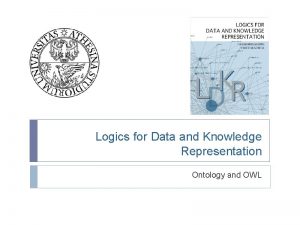Logics for Data and Knowledge Representation Exercises Modeling

























- Slides: 25

Logics for Data and Knowledge Representation Exercises: Modeling Fausto Giunchiglia, Rui Zhang and Vincenzo Maltese

Outline q Modeling q Logical Modeling q Exercises with intensional models q Forest q Exercises with extensional models q Classroom q Family q My friends q Databases 2

MODELING : : LOGICAL MODELING : : INTENTIONAL MODELS : : EXTENSIONAL MODELS Modeling: from the world to its representation Language L Theory T Mental Model World Domain D SEMANTIC GAP 3 Data Knowledge Meaning Model M

MODELING : : LOGICAL MODELING : : INTENTIONAL MODELS : : EXTENSIONAL MODELS What and How World: the phenomenon we want to describe q Domain: the abstract relevant elements in the real world q Mental Model: what we have in mind. It is the first abstraction of the world (subject to the semantic gap) q Language: the set of words and rules we use to build sentences used to express our mental model q Model: the formalization of the mental model, i. e. the set of true facts in the language, in agreement with theory q Theory: the set of sentences (constraints) about the world expressed in the language that limit the possible models q q 4 NOTE: this does not necessarily need to be in formal semantics

MODELING : : LOGICAL MODELING : : INTENTIONAL MODELS : : EXTENSIONAL MODELS Example of informal Modeling Mental Model World Language L Domain D Theory T Model M L: Informal description in NL D: {monkey, banana, tree} T: If the monkey climbs on the tree, he can get the banana M: The monkey actually climbs on the tree and gets the banana SEMANTIC GAP 5 NOTE: a database can be seen as an informal model

MODELING : : LOGICAL MODELING : : INTENTIONAL MODELS : : EXTENSIONAL MODELS Logical Modeling Language L Realization Domain D SEMANTIC GAP 6 Mental Model Meaning Theory T ⊨ Entailment I World Interpretation Modeling Data Knowledge Model M NOTE: the key point is that in logical modeling we have formal semantics

MODELING : : LOGICAL MODELING : : INTENTIONAL MODELS : : EXTENSIONAL MODELS What and How q World: the phenomenon that we are observing and want to model q Domain (D) = the abstract relevant objects from the world q Language (L) = a logical language with formal syntax and semantics: q The formal syntax is given by the set of rules to construct complex sentences (the grammar) q The formal semantics is given by the interpretation function I: L → D q Model (M) = the abstract (mathematical sense) representation of the intended truths via the interpretation I of the language L. q M is called L-model of D q M ⊨ P, indicates that M satisfies P q Theory (T) = the set of facts/constraints expressed in the language L. q A fact defines a piece of knowledge (about D), something true in the model. 7

MODELING : : LOGICAL MODELING : : INTENTIONAL MODELS : : EXTENSIONAL MODELS Example of formal (intentional) Modeling Mental Model World Language L Domain D Theory T Model M L = {Monkey, Climbs, Get. Banana, , , } D= {T, F} T = { (Monkey Climbs) Get. Banana} A possible model M: I(Monkey) =T I(Climbs) =T I(Get. Banana) = T SEMANTIC GAP 8

MODELING : : LOGICAL MODELING : : INTENTIONAL MODELS : : EXTENSIONAL MODELS Example of formal (extensional) Modeling Mental Model World Language L Domain D Theory T Model M L = {Monkey, Climbs, Get. Banana, , , } D= {Cita, That. Banana} T = { Climbs Get. Banana} A possible model M: I(Monkey) = Cita I(Climbs) = Cita I(Get. Banana) = That. Banana SEMANTIC GAP 9

MODELING : : LOGICAL MODELING : : INTENTIONAL MODELS : : EXTENSIONAL MODELS Modeling Exercise: Forest q Description: There are two lions, Kimba and Simba, in the forest. They are in competition for the food. There is a nice antelope they want to hunt. If they want to survive they have to catch it. q Problem: Model the problem by identify relevant objects, defining the domain, the language, theory and providing a possible intentional model. 10

MODELING : : LOGICAL MODELING : : INTENTIONAL MODELS : : EXTENSIONAL MODELS Solution: Forest (I) q Description: There are two lions, Kimba and Simba, in the forest. They are in competition for the food. There is a nice antelope they want to hunt. If they want to survive they have to catch it. Relevant objects are in red D = {T, F} L = {Lion, Antelope, Survive, Catch} 11

MODELING : : LOGICAL MODELING : : INTENTIONAL MODELS : : EXTENSIONAL MODELS Solution: Forest (II) q q A possible model: I (Lion) =T I (Antelope) =T I (Catch) =T I (Survive) =T The theory T: Antelope (Catch Survive) Antelope Catch q I above is a model for T q I below is NOT a model for T I (Lion) =T I (Antelope) =F I (Catch) =F I (Survive) =T 12

MODELING : : LOGICAL MODELING : : INTENTIONAL MODELS : : EXTENSIONAL MODELS Modeling Exercise: Classroom q Description: In a class there are several persons. Usually there is one professor who teaches to some students. Students can be Master students or Ph. D students. Among Ph. D students there might be some Assistants of the professor. q Problem: Model the problem by identify relevant objects, defining the domain and the language, and providing a possible extensional model for it. 13

MODELING : : LOGICAL MODELING : : INTENTIONAL MODELS : : EXTENSIONAL MODELS Solution: Classroom (I) q Description: In a class there are several persons. Usually there is one professor who teaches to some students. Students can be Master students or Ph. D students. Among Ph. D students there might be some Assistants of the professor. Relevant objects are in red L = {Person, Professor, Student, Master, Ph. D, Assistant} D = {Fausto, Mary, Paul, Jane} 14

MODELING : : LOGICAL MODELING : : INTENTIONAL MODELS : : EXTENSIONAL MODELS Solution: Classroom (II) q The corresponding Venn diagram U Ph. D Assistant Student Master 15 Professor Person

MODELING : : LOGICAL MODELING : : INTENTIONAL MODELS : : EXTENSIONAL MODELS Solution: Classroom (III) q. A possible model: I (Person) = {Fausto, Mary, Paul, Jane} I (Professor) = {Fausto} I (Student) = {Mary, Paul, Jane} I (Master) = {Mary} I (Ph. D) = {Paul, Jane} I (Assistant) = {Paul} 16

MODELING : : LOGICAL MODELING : : INTENTIONAL MODELS : : EXTENSIONAL MODELS Modeling Exercise: Family q Description: My family consists of several members. There is a grandparent and my parents. Then there are some children, i. e. two sisters, one brother and me q Problem: Model the problem by identify relevant objects, defining the domain and the language, and providing a possible extensional model for it. 17

MODELING : : LOGICAL MODELING : : INTENTIONAL MODELS : : EXTENSIONAL MODELS Solution: Family (I) q Description: My family consists of several members. There is a grandparent and my parents. Then there are some children, i. e. two sisters, one brother and me Relevant objects are in red L = {member, grandparent, child, brother, sister, me} D = {Bob, Fausto, Mary, Paul, Jane, Hugo, Robert} 18

MODELING : : LOGICAL MODELING : : INTENTIONAL MODELS : : EXTENSIONAL MODELS Solution: Family (II) q The corresponding Venn diagram U Grandparent Parent Member Brother Child 19 Sister Me

MODELING : : LOGICAL MODELING : : INTENTIONAL MODELS : : EXTENSIONAL MODELS Solution: Family (III) q. A possible model: I (Member) = {Bob, Fausto, Mary, Paul, Jane, Hugo, Robert} I (Grandparent) = {Bob} I (Parent) = {Fausto, Mary, Bob} I (Brother) = {Robert, Paul} I (Sister) = {Jane} I (Me) = {Hugo} 20

MODELING : : LOGICAL MODELING : : INTENTIONAL MODELS : : EXTENSIONAL MODELS Modeling Exercise: My friends q Description: I have a lot of friends. I met some of them on the forum of my website. However, only a few of them are close to me. In particular, I use to play chess with Paul. q Problem: Model the problem by identify relevant objects, defining the domain and the language, and providing a possible extensional model for it. 21

MODELING : : LOGICAL MODELING : : INTENTIONAL MODELS : : EXTENSIONAL MODELS Solution: My friends (I) q Description: I have a lot of friends. I met some of them on the forum of my website. However, only a few of them are close to me. In particular, I use to play chess with Paul. Relevant objects are in red L = {Friend, Forum, Close, Playing. Chess} D = {Bob, Fausto, Mary, Paul, Jane, Hugo, Robert} 22

MODELING : : LOGICAL MODELING : : INTENTIONAL MODELS : : EXTENSIONAL MODELS Solution: My friends (II) q The corresponding Venn diagram Friend Forum Playing. Chess Close 23 U

MODELING : : LOGICAL MODELING : : INTENTIONAL MODELS : : EXTENSIONAL MODELS Solution: My friends (III) q. A possible model: I (Friend) = {Bob, Paul, Jane, Robert, Richard, Samuel} I (Forum) = {Bob, Paul, Jane} I (Close) = {Bob, Paul, Samuel} I (Playing. Chess) = {Paul} 24

MODELING : : LOGICAL MODELING : : INTENTIONAL MODELS : : EXTENSIONAL MODELS A Database ID Name Nationality Hair Color Affiliation 1 Fausto Italian White Professor 2 Enzo Italian Black Ph. D Closed world assumption (CWA): The assumption that what is not currently 3 Rui Chinese Black Assistant known to be true, is false. 4 … I (Italian) = {Fausto, Enzo} 5 … I (Black. Hair) = {Enzo, Rui} … … … q q Italian Black. Hair 25 Class Ph. D Open world assumption (OWA): anything which is not explicitly asserted is unknown. Is Rui Italian? This is not asserted in the DB, therefore it is unknown.
 Role modeling theory
Role modeling theory Knowledge representation in data mining
Knowledge representation in data mining Message design logics
Message design logics Kr logics
Kr logics Message design logics
Message design logics Sage saleslogix support
Sage saleslogix support Q logics
Q logics Sales logics crm
Sales logics crm Relational vs dimensional data modeling
Relational vs dimensional data modeling Advantages of solid geometric models
Advantages of solid geometric models Data modeling best practices for data warehousing
Data modeling best practices for data warehousing Numeric data representation
Numeric data representation Script knowledge representation
Script knowledge representation Mapping between facts and representation
Mapping between facts and representation Decision trees show the logic structure in a
Decision trees show the logic structure in a Typical process description tools include
Typical process description tools include Knowledge creation and knowledge architecture
Knowledge creation and knowledge architecture Data vault pit table example
Data vault pit table example Data and program representation
Data and program representation Data representation and computer arithmetic
Data representation and computer arithmetic Tabular and graphical representation of data
Tabular and graphical representation of data Data representation and organization
Data representation and organization Characteristics of inter process communication
Characteristics of inter process communication Tabular and graphical representation of data
Tabular and graphical representation of data Shared and personal knowledge
Shared and personal knowledge Knowledge shared is knowledge squared meaning
Knowledge shared is knowledge squared meaning

